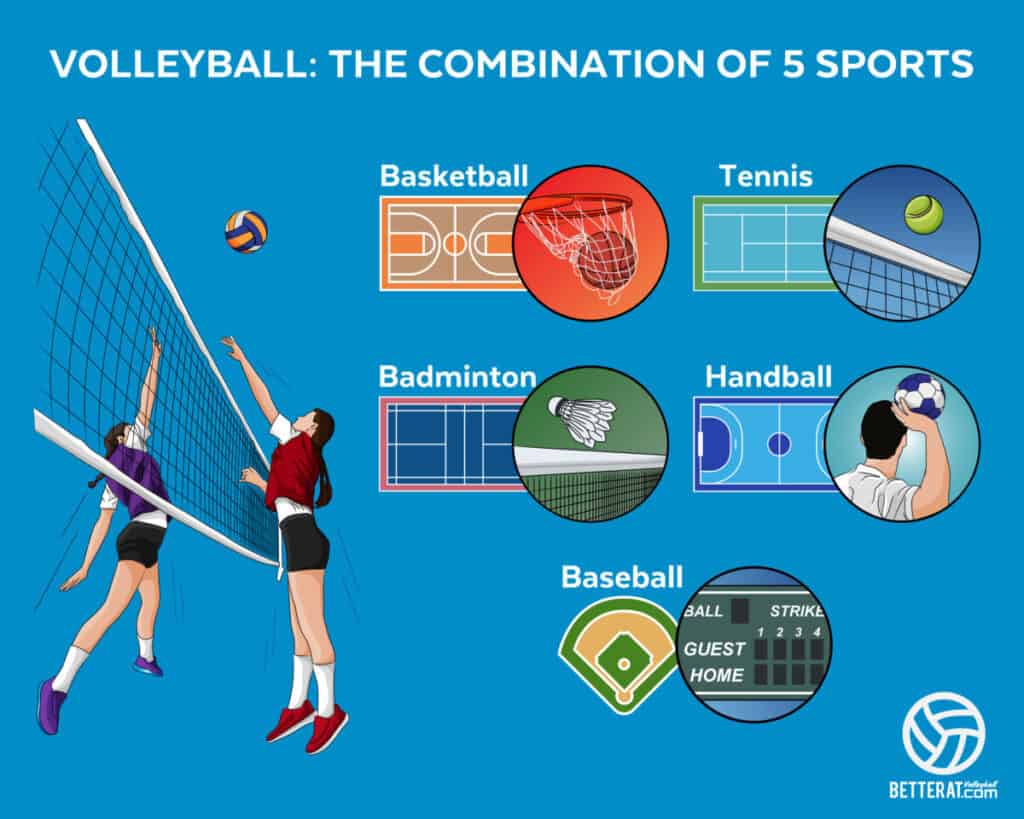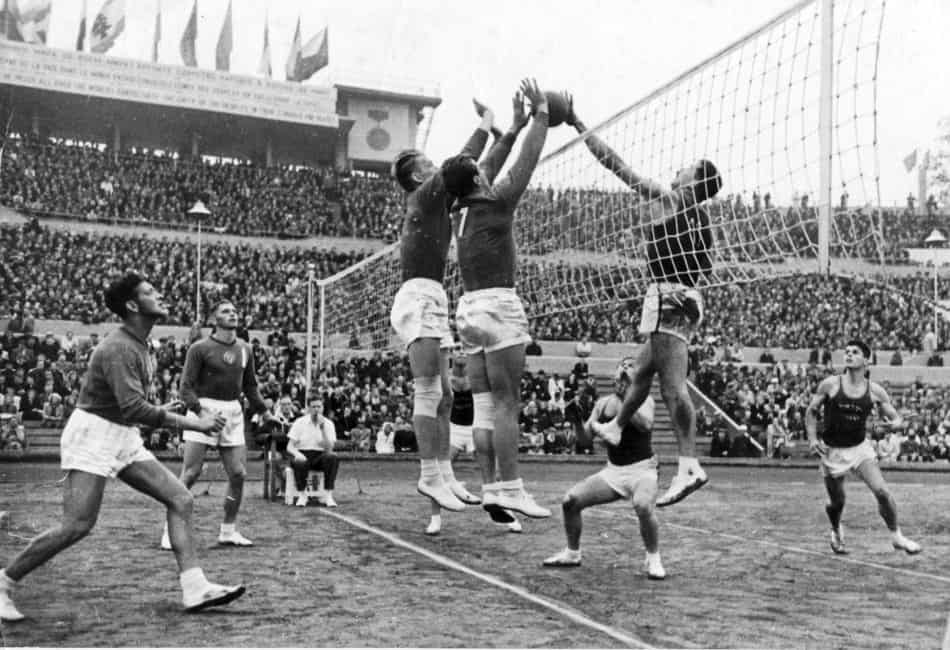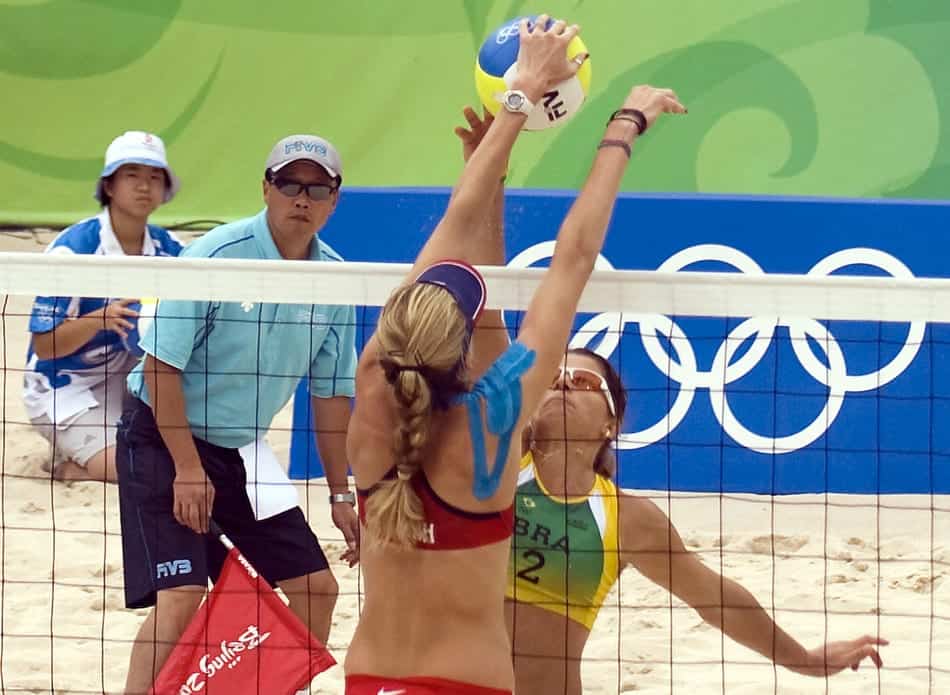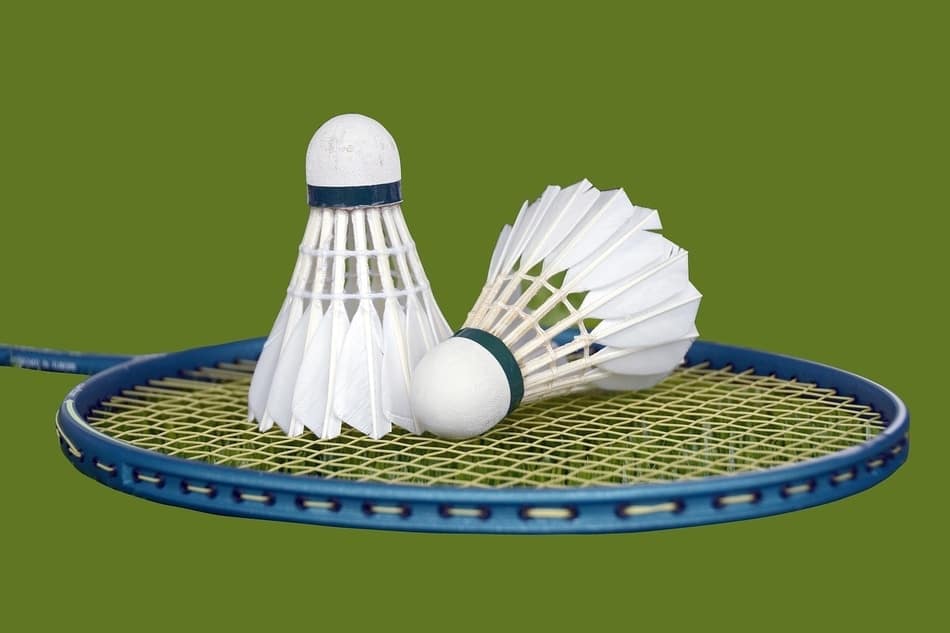You may have wondered from time to time, where did the sport of volleyball come from? Who invented it and which country did it begin with?
Who invented volleyball? His name was William G. Morgan (1870-1942). He was from New York and living in Massachusetts at the time, so the sport is definitely American.
Volleyball: In The Beginning
William Morgan went to Springfield College of the YMCA and while he was there, played football. He was athletic and excelled at sports to the point that he made it his career choice as he left college.
While at Springfield, he met James Naismith. James invented basketball in 1891 and had an influence on William, encouraging him to continue in sports. After graduating, William became an athletic director at the YMCA in Massachusetts. As he was developing his program he had great influence over a large number of young men.

In 1895 William invented a game he named “Mintonette” mainly as an alternative to basketball for older athletes, members of the YMCA community. He wanted a sport that was less violent and physically demanding. While children and youth certainly enjoyed basketball, many of the adult men didn’t appreciate how rough it was.
So What Was The Original Name of Volleyball?
When he originally named it, volleyball was first called Mintonette. If that sounds strange to you, read on and you’ll understand why.
This sport was viewed as something athletes could play indoors when the weather or season made it impossible to play other sports outside. They could be competitive but avoid injury.

So Morgan basically wanted to come up with a combination of 5 sports; basketball, tennis, baseball, badminton, and handball. He wanted to use a ball similar to basketball. He thought of using the net from tennis. Baseball inspired him to have several periods of play like innings (what we now call sets). Badminton also used a similar net and the idea of getting it back to the opponent’s side without it touching the ground. He used handball as a starting place when thinking about how the players would contact the ball.
He began by borrowing a tennis net and raising it up over 6 ½ feet so that it would be taller than the average man. He experimented with different balls.
A basketball was too heavy. They tried the bladder from a basketball, but it was too light and slow. Eventually, he would enlist experts to design a unique ball for his sport.
Early on, they played on a smaller court. Where today’s court is about 60 feet long and 30 feet wide, their court was just 50 feet by 25 feet. Picture this scene with an unlimited number of players, this game could get pretty crowded! There was also no limit to the number of hits your team could make before sending the ball to the other side, you just couldn’t let it touch the ground.
Initially, they played games that had 9 innings (or sets). In each set, they had just 3 serves (think of the “outs” in baseball).
What’s even more funny to think about, players were allowed to help the ball over if the server didn’t hit it hard enough to make it over the net. If you messed up your first attempt at the serve, you were allowed a second try. This echoes the system in tennis where a foul first serve is very common and you simply get another chance.
In 1896 the YMCA athletic directors gathered for a conference and Morgan was asked to demonstrate his new game. He recruited 2 teams of 5 men and brought some fans from his local group. They all went to the conference and put on a clinic.
In the beginning, Morgan encouraged playing with an unlimited number of players. He explained at the conference that this new game was designed to play in indoor gyms, but that it would work well playing outdoors too.
Quote:
After seeing the demonstration, and hearing the explanation of Morgan, Professor Alfred T. Halstead called attention to the action, or the act
http://www.fivb.org/en/volleyball/History.asp
phase, of the ball’s flight, and proposed that the name “Mintonette” be replaced by “Volley Ball.” This name was accepted by Morgan and the conference. (It is interesting to note that the same name has survived over the years, with one slight alteration: in 1952, the Administrative Committee of the USVBA voted to spell the name with one word, “Volleyball.”
By 1897, the YMCA published a standard set of rules to be followed in the new sport of Volley Ball.
William asked A.G. Spalding & Bros. to create a ball for his new sport. Even though it was first made in 1900, it was surprisingly similar to the ball we use today.
International Growth Of Volleyball
The game spread through the YMCA and in 1910 Canada became the first foreign country to adopt Volley Ball. Over the next decade, Volleyball would spread across the world, being adopted in Japan, China, the Philippines, Burma, India, Mexico, and across South America, Europe, and Africa.

While it was expanding overseas, the new sport was taking off in the United States as well. It spread from the YMCA (Young Men’s Christian Association) to the YWCA (Young Women’s Christian Association). Then to schools and colleges all across the country.
In 1916, the YMCA convinced the NCAA to publish the rules of volleyball and a series of articles about the sport. This led to rapid expansion and general awareness throughout the U.S.A.
Evolution Of The Sport of Volleyball
In the early days, there were very few rules in the game. The objective was for your team to keep the ball from hitting the ground on your side of the net and sending it back to the other side. There were no limits on the number of players, no limit to the number of hits your team could make and there was no concept of offense.
The Philippine teams get the credit for coming up with the first concepts of setting and spiking in 1916. This quickly caught on and became very popular.
In 1918 the NCAA decided to fix the number of players per team to 6. In 1920, the back row rules were added. In 1922, the number of hits per side was limited to 3 and the double hit rules were introduced.
In 1924, volleyball was demonstrated in Paris at the Olympics but was not an official sport.
It became clear that there would need to be a standard set of rules for tournament play and so the USVBA (United States Volleyball Association) was formed in 1928.
In 1930, two-man beach volleyball made its debut. Professional beach volleyball wouldn’t begin for many years after.

In the 1940s the forearm pass was invented and accepted as a desperation play. Until then, pretty much all passes were overhead volleys or hits.
In 1949, the first World Championships were hosted in Prague, Czechoslovakia.
In 1955, Volleyball was included in the Pan American Games.
In 1968, the antennae were added to help the referee hold teams accountable for playing within their zone and the air space above their zone.
In 1983 the AVP (American Volleyball Professionals) began. Just a few years later, in 1986, the Women’s Professional Volleyball Association (WPVA) was formed.
In 1964 in the Tokyo Summer Games, volleyball joined the Olympics. The U.S. began a full-time women’s national team in 1975 and then added the men’s national team two years later in 1977.
In 1994 the service zone was extended to allow servers to stand at any point behind the end line. If the sidelines continued in a straight line, those would be the boundaries of the service zone.
In 1998 the libero was added to international volleyball. Over the next few years, it would be adopted into the college level and then high schools.
In 2000 a few more rules were changed. Net serves were eliminated. If the ball made contact with the net it didn’t cause a fault, it either went over or it didn’t. Also, rally scoring was introduced. Before this, you only received points for the plays you won if your team was the one who served. If the other team served, you simply gained possession of the serve.
To learn more about the difference between rally scoring and side-out scoring, check out this article.
The Beach Volleyball Explosion
Although the first two-man beach volleyball was played in 1930, the first tournament wasn’t until 1948. In 1965, the California Beach Volleyball Association (CBVA) was formed.
In 1996 Beach Volleyball became an Olympic sport and was immediately one of the most popular sports in the summer games. Over 1 billion people tuned in to watch the first live beach volleyball that year.

The addition to the Olympics and the success of the American teams in the games since 1996 has prompted an absolute explosion of growth throughout the American sports community. Colleges and high schools have been adding programs to their athletic departments, whether they call them beach volleyball or sand volleyball.
Related Questions
Where Did The Name Mintonette Come From?
When William Morgan was creating the game and combining different ideas from different sports, one that influenced his vision of this new game was badminton. At the time, badminton had been around for almost 50 years and was a very common sport.

It is played inside or outdoors. It involves serving a shuttlecock to your opponent and each taking turns to hit it back and forth within the court without letting it hit the ground. When you think about it, it’s pretty similar to the early days of volleyball.
So he took “minton” and modified it to mintonette. It was very short-lived and was soon renamed volley ball, and later changed to volleyball.
Is Volleyball The National Game In Any Countries?
Sri Lanka names volleyball as its national game. Other countries that consider it one of their top games are: Brazil, China, Cuba, Estonia, Papua New Guinea, Romania, and Turkey. Current estimates are that between 900 million and 1 billion people around the world play volleyball frequently. That easily puts volleyball in the top 10 most played sports around the world, sometimes it is estimated to rank as high as #2, behind the runaway favorite sport, football (also called soccer).
What Is Newcomb Ball (also called Nuke ‘Em Ball)?
This is a game similar to volleyball where the players catch and throw the ball instead of hitting or passing it. It is played on the same court, with the same net, sometimes with a volleyball, but sometimes with a ball of a different type. In the early years, it rivaled volleyball in popularity up until the 1920s. It is still played by children today.
Would you like to learn more about Nuke ‘Em?
Photo credits:
William Morgan image in the public domain: https://commons.wikimedia.org/wiki/File:William_G._Morgan.jpg
International flag image by Guilhem Vellut on flickr.com: https://creativecommons.org/licenses/by/2.0/, cropped to zoom in.
Black and white men’s game image available in the public domain: https://commons.wikimedia.org/wiki/File:PikiWiki_Israel_3963_Gan-Shmuel_sg5-_28.jpg
Olympic beach image by Craig Maccubbin on flickr.com: https://creativecommons.org/licenses/by/2.0/, cropped.
Badminton image by Karen Arnold from Pixabay
Resources:
https://en.wikipedia.org/wiki/Volleyball
http://www.fivb.org/en/volleyball/History.asp
http://volleyball.org/history.html
Recent Posts
Athletes, listen up! Do you have a closet full of old jerseys, sweatpants, and tees that you just can't seem to part with? Well, dust them off, because you're sitting on a goldmine of fashion...
You may have heard, or you may have noticed, that there's been a change to the rule about double contact in volleyball. In 2022, an experimental rule change began to be implemented, where the double...
